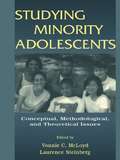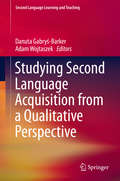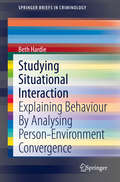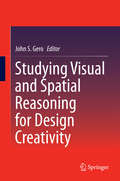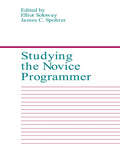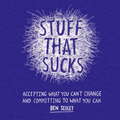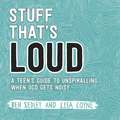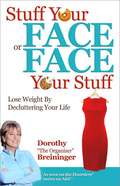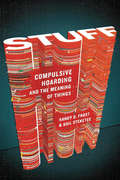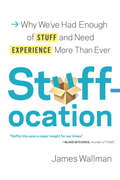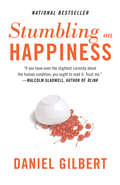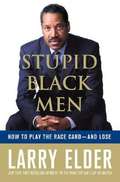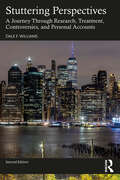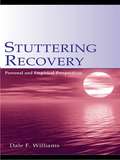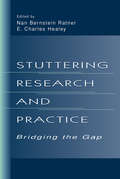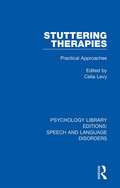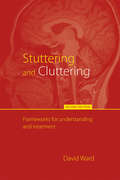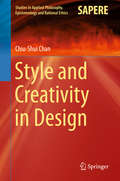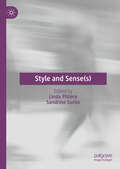- Table View
- List View
Studying Minority Adolescents: Conceptual, Methodological, and Theoretical Issues
by Laurence Steinberg Vonnie C. McLoydIn the burgeoning research literature on adolescents, the relative paucity of work examining ethnic variations in developmental processes is a glaring gap, particularly because approximately one third of American young people now come from an ethnic minority background. A primary factor in this research imbalance has been the lack of training in methods and research instruments needed to properly study ethnically diverse populations. This book was developed in response to this need. Its chief objective is to present recent theoretical, conceptual, and methodological advances in the study of ethnicity and development during adolescence. The chapters address fundamental and enduring issues concerning the incorporation of ethnicity into research designs. Topics such as demographics, "ethnicity-friendly" research paradigms, and practical challenges that arise throughout the research cycle are addressed by scholars who have "been there" and learned how to successfully study the effects of race and ethnicity on developmental processes and outcomes. Established scholars and newcomers to research, working both in academic and applied settings with adolescents as their focus, will find this book a valuable resource.
Studying Second Language Acquisition from a Qualitative Perspective
by Danuta Gabryś-Barker Adam WojtaszekThis book presents a selection of empirical papers dealing with second and multiple language acquisition, in which qualitative research methodology is employed. Each of the studies reported in individual chapters is based on a solid theoretical background and an overview of studies in a given area. Although the main focus is on qualitative methods, some of the papers demonstrate the complementarity of quantitative and qualitative approaches in studying language acquisition.
Studying Situational Interaction: Explaining Behaviour By Analysing Person-Environment Convergence (SpringerBriefs in Criminology)
by Beth HardieIn response to misconceptions and sub-optimal assessment of situational interaction in the criminological literature, this volume is a comprehensive resource for researchers of person-environment interaction in human behavioural outcomes, with a focus on acts of crime. It provides a bridge between strong complex theory about causal situational interaction in crime and the appropriate methods for empirically testing proposed situational mechanisms. It is underwritten by the principle that research should be driven by theory and served by method.This volume clarifies the key concepts of interaction and situation within the framework of Situational Action Theory (SAT). It details the implications of these conceptual issues for an appropriate integrative analytical approach to data collection and analysis that places situational interaction at the heart of research into the causes of behaviour (such as acts of crime). Using existing examples of attempts to analyse person-environment interaction, the volume distinguishes and showcases different methods and evaluates their appropriateness for the study of situational interaction in behaviour. Appropriate for researchers in criminology and the behavioural sciences more generally, Studying Situational Interaction is essential for those studying the individual and environmental causes of human actions such as crime.
Studying Visual and Spatial Reasoning for Design Creativity
by John S. GeroCreativity and design creativity in particular are being recognized as playing an increasing role in the social and economic wellbeing of a society. As a consequence creativity is becoming a focus of research. However, much of this burgeoning research is distributed across multiple disciplines that normally do not intersect with each other and researchers in one discipline are often unaware of related research in another discipline. This volume brings together contributions from design science, computer science, cognitive science and neuroscience on studying visual and spatial reasoning applicable to design creativity. The book is the result of a unique NSF-funded workshop held in Aix-en-Provence, France. The aim of the workshop and the resulting volume was to allow researchers in disparate disciplines to be exposed to the other's research, research methods and research results within the context of design creativity. Fifteen of the papers presented and discussed at the workshop are contained in this volume. The contributors come from Germany, Israel, Netherlands, Poland, Singapore, UK and USA, indicating the international spread of the research presented in this volume.
Studying individual Development in An interindividual Context: A Person-oriented Approach (Paths Through Life Series #Vol. 4)
by Lars R. Bergman David Magnusson Bassam M. El KhouriDuring the last decade there has been increased awareness of the limitations of standard approaches to the study of development. When the focus is on variables and relationships, the individual is easily lost. This book describes an alternative, person-oriented approach in which the focus is on the individual as a functioning whole. The authors take as their theoretical starting points the holistic-interactionistic research paradigm expounded by David Magnusson and others, and the new developmental science in which connections and interactions between different systems (biological, psychological, social, etc.) are stressed. They present a quantitative methodology for preserving--to the maximum extent possible--the individual as a functioning whole that is largely based on work carried out in the Stockholm Laboratory for Developmental Science over the past 20 years. The book constitutes a complete introductory guide to the person-oriented approach. The authors lay out the underlying theory, a number of basic methods, the necessary computer programs, and an extensive empirical example. (The computer programs have been collected into a statistical package, SLEIPNER, that is freely accessible on the Internet. The empirical example deals with boys' school adjustment from a pattern perspective and covers both positive and negative adaptation.) Studying Individual Development in an Interindividual Context: A Person-Oriented Approach will be crucial reading for all researchers who seek to understand the complexities of human development and for their advanced students.
Studying the Novice Programmer (Interacting with Computers Series)
by James C. Spohrer Elliot SolowayParallel to the growth of computer usage in society is the growth of programming instruction in schools. This informative volume unites a wide range of perspectives on the study of novice programmers that will not only inform readers of empirical findings, but will also provide insights into how novices reason and solve problems within complex domains. The large variety of methodologies found in these studies helps to improve programming instruction and makes this an invaluable reference for researchers planning studies of their own. Topics discussed include historical perspectives, transfer, learning, bugs, and programming environments.
Stuff That Sucks: Accepting what you can't change and committing to what you can (The\instant Help Solutions Ser.)
by Ben SedleyEach of us has thoughts that are painful at times; sometimes the pain is sadness, sometimes worry or anger or shame or grief or some feeling that you don't even have words for. If you are a young person struggling with your emotions, you do not want to be told that 'everyone feels like that' or that 'you will grow out of it'. You want to feel that your emotions are valid and that the person offering help truly understands how painful life can feel at times. With a strong emphasis on validation and compassion, Stuff That Sucks encourages you to accept your emotions rather than struggling against them. It also shows how to reconnect with what is really important to you, giving you the tools to help clarify your personal values and take steps towards living a life where those values can guide you in your day-to-day behaviour.
Stuff That's Loud: A Teen's Guide to Unspiralling when OCD Gets Noisy
by Ben Sedley Lisa CoyneDo you have thoughts that seem loud? Do your worries spiral out of control and then suck you in? Do intrusive thoughts show up and make you scared of doing certain things - or not doing things - a certain way? Do you ever get a feeling like something bad might happen? Does this loud stuff make you feel alone, or worse, crazy?First, you aren't alone - even if it sometimes feels that way. And second, you are not crazy. But you might be struggling with obsessive compulsive disorder (OCD). And while OCD can be difficult, you don't have to let it have power over you. Instead, you can live a life full of meaning, great relationships and joy with the help of this book.In Stuff That's Loud, you'll learn Exposure and Response Prevention (ERP) and ideas from Acceptance and Commitment Therapy (ACT) to help you break free from loud, spiralling OCD thoughts and behaviours:- You'll learn to be curious about the world around you- You'll use willingness to step forwards boldly - You'll develop flexibility skills to practice everywhere and everywhen- You'll focus on living a life that you give a $#@! aboutLife doesn't have to stay stuck any longer.
Stuff Your Face or Face Your Stuff: The Organized Approach to Lose Weight by Decluttering Your Life
by Dorothy BreiningerWhile organizing the lives of her many clients, Emmy-nominated organizing expert Dorothy Breininger learned to face her own stuff, and lost seventy-five pounds in the process. In this one-of-a-kind book she addresses weight loss from the much-needed perspective of what lies underneath our clutter—metaphorically, physically, and emotionally. Whether you're a packrat or a calorie-counter, a neat freak or a binge eater, Breininger reveals why, to be successful on the scale, you must first master the clutter within you and around you. With the same no-holds barred candor that resonates with TV viewers, she offers prescient advice to help anyone face their stuff, with an organized, step-by-step approach to either toss it, tame it, or tailor it to fit their lives. Filled with personal stories from clients, her own success story, and tips from fitness coaches and organizing experts, this imminently practical book gives everyone the tools to declutter their way to their dream size.
Stuff: Compulsive Hoarding and the Meaning of Things
by Gail Steketee Randy O. FrostThe New York Times bestseller. &“Gripping . . . By turns fascinating and heartbreaking . . . Stuff invites readers to reevaluate their desire for things.&”—Boston Globe &“Amazing . . . utterly engrossing . . . Read it.&”—The Washington Post Book World What possesses someone to save every scrap of paper that&’s ever come into his home? What compulsions drive a person to sacrifice her marriage or career for an accumulation of seemingly useless things? Randy Frost and Gail Steketee were the first to study hoarding when they began their work a decade ago. They didn&’t expect that they would end up treating hundreds of patients and fielding thousands of calls from the families of hoarders. Their vivid case studies (reminiscent of Oliver Sacks) in Stuff show how you can identify a hoarder—piles on sofas and beds that make the furniture useless, houses that can be navigated only by following small paths called goat trails, vast piles of paper that the hoarders &“churn&” but never discard, even collections of animals and garbage—and illuminate the pull that possessions exert over all of us. Whether we&’re savers, collectors, or compulsive cleaners, very few of us are in fact free of the impulses that drive hoarders to extremes. &“Authoritative, haunting, and mysterious. It is also intensely, not to say compulsively readable.&”—Tracy Kidder, Pulitzer Prize-winning author &“Fascinating . . . a good mix of cultural and psychological theories on hoarding.&”—Newsweek &“Pioneering researchers offer a superb overview of a complex disorder that interferes with the lives of more than six-million Americans . . . An absorbing, gripping, important report.&”—Kirkus Reviews (starred review)
Stuffocation: Why We've Had Enough of Stuff and Need Experience More Than Ever
by James WallmanStuffocation is a movement manifesto for "experiential" living, a call to arms to stop accumulating stuff and start accumulating experiences, and a road map for a new way forward with the potential to transform our lives.Reject materialism. Embrace experientialism. Live more with less. Stuffocation is one of the most pressing problems of the twenty-first century. We have more stuff than we could ever need, and it isn't making us happier. It's bad for the planet. It's cluttering up our homes. It's making us stressed--and it might even be killing us. A rising number of us are already turning our backs on all-you-can-get consumption. We are choosing access over ownership, and taking our business to companies like Zipcar, Spotify, and Netflix. Fed up with materialism, we are ready for a new way forward. Trend forecaster James Wallman traces our obsession with stuff back to the original Mad Men, who first created desire through advertising. He interviews anthropologists studying the clutter crisis, economists searching for new ways of measuring progress, and psychologists who link stuffocation to declining well-being. And he introduces us to the innovators who are already living more consciously and with more meaning by choosing experience over stuff. Experientialism does not mean giving up all of our possessions. It is a solution that is less extreme but equally fundamental. It's about transforming what we value. Stuffocation is a paradigm-shifting look at our habits and an inspiring call for living more with less. It's the one important book you won't be able to live without. What People Are Saying About Stuffocation "James Wallman deftly hits upon a major insight for our times: that acquiring 'stuff' and 'things' is not nearly as meaningful as collecting experiences. Some of the happiest days of my life were when I had nothing and lived on a houseboat. Without stuff to tie me down, I felt completely free."--Blake Mycoskie, founder of TOMS and author of the New York Times bestseller Start Something That Matters "Stuffocation is a must-read. We think that more stuff will make us happier, but as the book nicely shows, we're just plain wrong. A great mix of stories and science, Stuffocation reveals the downside of more, and what we can do about it."--Jonah Berger, author of the New York Times bestseller Contagious "In Stuffocation, James Wallman offers a deeply important message by weaving contemporary social science into very engaging stories. Reading the book is such a pleasure that you hardly recognize you're being told that you should change how you live your life."--Barry Schwartz, author of The Paradox of Choice "With a sociologist's eye and a storyteller's ear, James Wallman takes us on a tour of today's experience economy from the perspective not of businesses, nor even of consumers per se, but of everyday people. In doing so, he identifies the rise of a new value system among those who are consciously replacing materialism with what he rightly calls experientialism. Spot on."--B. Joseph Pine II and James H. Gilmore, authors of The Experience Economy "Stuffocation explains how less but better stuff and space can lead to more time, more experiences, more connecting with people, and therefore more happiness. Designed right, small is the new big."--Graham Hill, founder, LifeEdited.com and TreeHugger.comFrom the Hardcover edition.
Stumbling on Happiness
by Daniel Gilbert* Why are lovers quicker to forgive their partners for infidelity than for leaving dirty dishes in the sink?* Why will sighted people pay more to avoid going blind than blind people will pay to regain their sight? * Why do dining companions insist on ordering different meals instead of getting what they really want? * Why do pigeons seem to have such excellent aim; why can't we remember one song while listening to another; and why does the line at the grocery store always slow down the moment we join it?In this brilliant, witty, and accessible book, renowned Harvard psychologist Daniel Gilbert describes the foibles of imagination and illusions of foresight that cause each of us to misconceive our tomorrows and misestimate our satisfactions. Vividly bringing to life the latest scientific research in psychology, cognitive neuroscience, philosophy, and behavioral economics, Gilbert reveals what scientists have discovered about the uniquely human ability to imagine the future, and about our capacity to predict how much we will like it when we get there. With penetrating insight and sparkling prose, Gilbert explains why we seem to know so little about the hearts and minds of the people we are about to become.From the Trade Paperback edition.
Stupid Black Men: How to Play the Race Card - and Lose
by Larry ElderIS LIFE UNFAIR FOR BLACK AMERICANS? IS RACIAL EQUALITY THE ANSWER TO EVERY QUESTION OF PUBLIC POLICY? IS A HUGE GROUP OF CITIZENS BEING KEPT DOWN BY "THE MAN"? RADIO HOST AND BESTSELLING AUTHOR Larry Elder has made a career out of being a thorn in the side of the conventional-wisdom crowd. He deflates the pompous and points out the completely logical truths hidden behind the nutty rhetoric and out-of-control pandering of politicians and the so-called leaders of a variety of special-interest groups. In Stupid Black Men, he takes on the mind-set of those people who always capture the most media attention-as well as masses of public money-people who say that racism is the root of all problems and who end up hurting precisely those they claim to be helping. Whether they are demagogues like Al Sharpton, established politicians like Hillary Clinton, or entertainers like Danny Glover, no one escapes Elder's cogent arguments and rapier wit. His sometimes hilarious and always infuriating examples of wrong-headedness skewer not just politicians for their smugness and hypocrisy but also actors, educators, religious leaders, and the "mainscream media" for keeping the story in the headlines. But Elder has a positive message, too: though they are fewer-and generally not as loudmouthed-there are leaders and role models today who want to sweep away race-based whining and urge everyone in America to share in the hard work, smart thinking, and optimism that make this country great.
Stuttering Perspectives: A Journey Through Research, Treatment, Controversies, and Personal Accounts
by Dale F. WilliamsStuttering Perspectives is a highly engaging book that interweaves discussion and research about stuttering with personal accounts. Written in a reader-friendly and informal style, the book considers stuttering from a variety of angles, providing the reader with a nuanced and holistic view. In this way, topics such as therapy, support groups, listener reactions, and many others are not only explained within the context of current research, but also illustrated with lively examples demonstrating the stuttering experience. Fully updated in its second edition, the book includes new stories, additional discussion questions, and inclusion of contemporary stuttering issues not contained in the original version. This book is highly relevant reading for speech and language professionals, as well as students of communication sciences and disorders. It will also be of great interest to people who stutter and anyone with an interest in fluency disorders.
Stuttering Recovery: Personal and Empirical Perspectives
by Dale F. WilliamsStuttering Recovery: Personal and Empirical Perspectives is a highly original and engaging book serving to not only educate readers on topics related to stuttering, but also to stimulate discussion. The author interweaves personal accounts of people who stutter with informational chapters highlighting up-to-date research on recovery-related issues such as therapy, support groups, listener reactions, risk-taking, and dealing with family members and significant others.Reader-friendly and understandable, this book incorporates various perspectives to teach and illustrate the different aspects of recovery. Chapters are paired with stories presenting all sides of the recovery process -- the humorous and serious, the uplifting and frustrating, the thoughtful and emotional, and everything in-between. The result is a text that is entertaining and instructive.Stuttering Recovery: Personal and Empirical Perspectives is intended for undergraduate and graduate students, clinicians, speech-language professionals, people who stutter, significant others, and anyone else who has an interest in fluency disorders.
Stuttering Research and Practice: Bridging the Gap
by Nan Bernstein Ratner and E. Charles HealeyCurrent approaches to treating stuttering do not reflect the new understanding of its nature which has emerged from recent studies. This book brings together speech scientists and clinicians to discuss the best ways to close the perceived gap and maximize the effectiveness of treatment. Together, the chapters offer a comprehensive state-of-the-art overview of the complexities of stuttering and its remediation. Genetic, neuropsychological, behavioral, and often-neglected affective and cognitive factors are all considered. Preferred methodologies for empirical investigation are described, and specific examples of applied clinical research designs are provided. The book will be crucial reading for all those professionally concerned with fluency disorders and their students.
Stuttering Therapies: Practical Approaches (Psychology Library Editions: Speech and Language Disorders)
by Celia LevyOriginally published in 1987, this book presented new ideas on the treatment of stuttering, by leading authorities within Britain at the time. There are chapters on children and adolescents, as well as on adults. In each chapter the author describes the therapeutic approach, how it fits into general views on the nature of stuttering, the clients for which it is appropriate, and possible methods of evaluation. The book is aimed at speech therapists and psychologists and provided an important up-date of the subject for practitioners.
Stuttering and Cluttering: Frameworks for Understanding and Treatment (Sources And Studies In World History Ser.)
by David WardStuttering and Cluttering provides a clear, accessible and wide-ranging overview of both the theoretical and clinical aspects of two disorders of fluency: stuttering and cluttering. This edition remains loyal to the idea that stuttering and cluttering can best be understood by first considering various overarching frameworks which can then be expanded upon, and provides a clear position from which to disentangle the often complex interrelationships of these frameworks.The book is divided into two parts, the first of which mainly deals with theory and aetiology, while the second focuses on clinical aspects of assessment, diagnosis and treatment. The book also provides frequent references across Parts I and II to help link the various areas of investigation together.This revised edition of Stuttering and Cluttering reflects the major changes in thinking regarding both theory and therapy that have taken place since the publication of the first edition. As well as those who stutter and clutter, the book will be invaluable for speech language therapy/speech language pathology students, practicing clinicians, psychologists and linguists around the world.
Style and Creativity in Design
by Chiu-Shui ChanThis book looks at causative reasons behind creative acts and stylistic expressions. It explores how creativity is initiated by design cognition and explains relationships between style and creativity. The book establishes a new cognitive theory of style and creativity in design and provides designers with insights into their own cognitive processes and styles of thinking, supporting a better understanding of the qualities present in their own design. An explanation of the nature of design cognition begins this work, with a look at how design knowledge is formulated, developed, structured and utilized, and how this utilization triggers style and creativity. The author goes on to review historical studies of style, considering a series of psychological experiments relating to the operational definition, degree, measurement, and creation of style. The work conceptually summarizes the recognition of individual style in products, as well as the creation of such styles as a process before reviewing studies on creativity from various disciplines, presenting case studies and reviewing works by master architects. Readers will discover how creativity is initiated by design cognition. A summary of the correlations between creativity and style, expressed as a conceptual formula describing the cognitive phenomenon of style and creativity concludes the work. The ideas presented here are applicable to all design fields, allowing designers to comprehend and improve their design processes to produce creative, stylistically unique products.
Style and Sense(s)
by Sandrine Sorlin Linda PillièreThis edited volume celebrates cutting-edge research in stylistics and, more specifically, recent work on sense and the senses. The title originated in the Poetics and Linguistics Association (PALA) 2022 conference and marks the 40th onsite event by showcasing some of the excellent papers delivered on that occasion. The selected chapters fall into 4 parts each of which gives pride of place to how style makes sense and how senses make style. The chapters follow research in neuroscience and sociocognition, investigate how body and mind are inextricably linked through embodied meaning; how emotions are both conveyed and perceived; and how impressions, thoughts and worldviews can be induced by a certain style. The apprehension of the senses is carried through a variety of theories (cognitive linguistics and stylistics, ecostylistics, phenomenology, simulation theory, enactivism, metaphor theory, Text World Theory) and is applied to various genres (poetry, novels, short stories, detectivefiction, restaurant reviews) and media (the oral vs written tradition, ekphrasis, and semiotic transfers). This book will be of interest to students and academics in stylistics, cognitive linguistics, discourse analysis, ecostylistics, and multimodality.
Stärker als die Schizophrenie
by Richard Carlson Jr. Aisha Meier-ChaoukiÜber das Buch: Bei Richard Carlson Jr. wurde im Alter von einundzwanzig Jahren paranoide Schizophrenie diagnostiziert. Seine Krankheit zeigte sich das erste Mal in der frühen Pubertät. Die moderne Psychiatrie hat bei Richard mehr als ein Jahrzehnt lang kolossal versagt. Erst nach einem Vorfall mit der Polizei verstand er wirklich, dass seine Diagnose stimmte, und endlich begann der lange Prozess der Genesung. Mehr als zehn Jahre später hat sich sein Leben stark verbessert. Im Verlauf seiner Behandlung erholte sich Richard auch von einer Depression, einer Zwangsstörung und Lethargie. Lassen Sie nicht zu, dass Ihnen, einem geliebten Menschen oder einem schwer psychisch kranken Patienten das Gleiche passiert wie Richard. Seien Sie immer ehrlich zueinander und zu Ihrem Psychiater.
Stärkung des kindlichen Selbstkonzepts
by Ina LangenkampLehrer/-innen, Erzieher/-innen oder im pädagogischen Bereich tätige Person sind im täglichenArbeitsalltag vor zahlreiche Herausforderungen gestellt. Die Autorin widmetsich in diesem Buch insbesondere der Stärkung des kindlichen Selbstkonzepts.Aufgrund von Interviews mit Teilnehmenden eines Patenschaftsprojekts (Kinderund Paten) werden wichtige Erkenntnisse zur Stärkung der verschiedenen Facettendes kindlichen Selbstkonzepts aus der 1:1 Situation im Patenschaftsprojekt aufdie 1: 29 Situation in einer Klasse übertragen. Im Zusammenhang mit wichtigentheoretischen Erkenntnissen (Selbstkonzeptforschung, Erziehungsstilforschung,Bindungstheorie, Selbstdiskrepanzen) werden konkrete, sofort umsetzbare,Handlungsalternativen im (schulischen) Arbeitsalltag mit Kindern entwickelt.Diese Implikationen wurden praktisch erprobt und mit Fallberichten angereichert.
Stärkung regulativer Kompetenzen durch entwicklungsbegleitende Psychotherapie
by Jan Philipp AdenDie Adaptation an die Bedingungen der Lebensphase des Alters verlangt von älteren Menschen hohe selbstregulatorische Leistungen. Die Selbstregulation nimmt daher eine Schlüsselposition für die Umsetzung erfolgreicher Alternsprozesse ein. Im Rahmen von zwei empirischen Teilstudien werden die Beziehungen unterschiedlicher selbst- und entwicklungsregulatorischer Faktoren mit Indikatoren erfolgreichen Alterns untersucht. Die Ergebnisse zeigen, dass selbstregulatorische Kompetenzen einen Beitrag zu erhöhtem Wohlbefinden im Alter leisten. Psychotherapie kann als entwicklungsbegleitende, kompensatorische Ressource fungieren, um die selbstregulatorischen Kompetenzen älterer Menschen zu stärken.
Störungen der Gedächtnisfunktion: Ein Überblick (essentials)
by Thorsten BartschGedächtnisprobleme sind eine der am häufigsten beklagten Beschwerden und haben in den letzten Jahren deutlich zugenommen. Gedächtnisstörungen treten nicht nur in Form von Demenzen, sondern auch im Rahmen von normalen Altersvorgängen auf. Das Essential behandelt in komprimierter Weise die Grundlagen der Gedächtnisfunktion und die häufigsten Gedächtnisstörungen, die im Alltag oder bei neurologischen oder psychiatrischen Erkrankungen auftreten können. Eine schnelle Orientierung für alle Ärzte, die Menschen mit Gedächtnisstörungen sehen, vor allem für Neurologen, Allgemeinmediziner, Psychiater und Psychotherapeuten.
Su Embarazo Semana a Semana
by Glade B. Curtis Judith SchulerWith millions of copies sold,Your Pregnancy Week by Weekis the best-selling, doctor-authored pregnancy and childbirth guide available. A translation of the up-to-date and expanded fifth edition,Su Embarazo Semana a Semanawill be the most medically current and comprehensive Spanish language guide for pregnant couples on the market. Organizing information in the medically appropriate, focused, and popular way-in weekly increments instead of monthly-each of the forty chapters ofSu Embarazo Semana a Semanafeatures: Detailed descriptions of baby’s growth and development each weekClear illustrations that show how both mother and baby are changing and growingDetailed descriptions of what readers may be experiencing each week, from average weight gain to feeling baby moveInformation about both routine and special medical tests that may be requiredTips on nutrition, overall maternal health, and how these things affect baby
